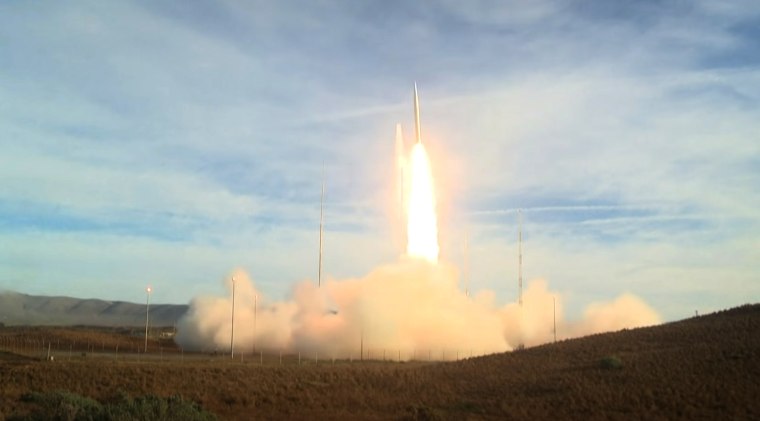At 8:30 a.m. on Dec. 12, a new type of U.S. ballistic missile shot off from its launchpad at Vandenberg Air Force Base, California, rocketing into the exosphere before arcing down into the Pacific Ocean over 310 miles away.
The test may have been dramatic, but it was essentially a very costly troll of the weapon's potential targets, Russia and China, because the United States can't actually use the weapon (which hasn't been publicly named) for reasons of geography and international politics.
The latest test simply raises the temperature on Beijing and Moscow without exerting real military pressure benefiting the United States. So why stretch defense dollars thinner to fund weapon systems the U.S. military can't even deploy in today's international climate?
The answer appears to be that it furthers Defense Secretary Mark Esper's ambition to see the United States deploy a class of weapon it hasn't operated since the recently scrapped Intermediate Nuclear Forces treaty (INF) went into effect in 1988. It's a take-the-gloves-off bid to wipe away the legacy of the pact, which the United States and Russia exited this summer.
The specific distance the Defense Department used to describe the flight of the conventional (non-nuclear) land-based missile echoes the language of the arms control treaty, indicating that it was linked to the agreement. These types of short- to intermediate-range missiles are popular with countries that expect to fight adversaries on the same continent, such as India or China. However, the United States is flanked by the Atlantic and Pacific oceans. Even if it slapped the new missile on the westernmost tip of Alaska, it could reach only the desolate eastern areas of Russia or the northeastern tip of China.
That means U.S. intermediate-range weapons would truly be useful only if deployed to a foreign territory closer to China or Russia. All other military adversaries are weaker, so such expensive weapons would be unnecessary. Although it's impossible to know this new missile's exact price, as cost overruns are more the rule than the exception, the 2020 defense budget granted a Pentagon request for $96 million to develop the newly tested missiles, along with two others. National Defense magazine projects that developing intermediate-range ballistic missiles would cost $1.1 billion and that the missiles could then be procured for $21 million apiece.
There's no foreign country within striking distance of China and Russia that's eager to provoke them by keeping the missiles — even if the host countries might theoretically benefit. China leverages devastating pressure against countries that hold U.S. missiles, and Russia isn't shy about issuing nuclear threats.
That leaves no takers. South Korea can barely stomach hosting even U.S. air defense missiles because of pressure from China, its chief trading partner. Australia, one of the United States' closest allies in Asia, explicitly stated its lack of interest in August. And the Philippines is a long shot because of Manila's warming relations with Beijing.
Japan's pro-U.S. government, meanwhile, opposed leaving the INF treaty and has avoided commenting on hosting U.S. missiles. Such a move would be so politically sensitive that it could require major expenditures of political and financial capital in Tokyo and Washington. And deploying missiles to Taiwan, an island that Beijing considers its sovereign territory, would surely trigger a military crisis, if not an outright war.
U.S. missiles could be crammed into Guam, a U.S. territory, or Palau, a staunch ally. But missiles deployed on tiny Pacific islands would be easy to pick off, while China and Russia can hide mobile launchers across their vast geographic bulks.
Similarly, in Europe, no state has declared itself willing to host U.S. land-based missiles that could strike Russia without NATO-wide consensus. The foreign minister of Poland, one of the countries most eager for additional U.S. military forces, still stated at a conference last year that "we are not very much in favor — we are definitely even against — deployment of missiles on our soil."
Supporters of deploying the new missile and others that have been stalled by the INF treaty resort to arguing that the weapon is worth having in the United States' quiver in case a crisis causes foreign partners to change their minds. They say the program is "affordable" because it's cheaper to put missiles on land-based launchers than on ships or planes. But that elides the fact that land-based missiles would be procured in addition to, not instead of, more flexible U.S. weapons.
Currently, there’s no foreign country within striking distance of China and Russia that’s eager to provoke them by keeping the missiles.
Moreover, the Pentagon has already invested hundreds of billions of dollars in stealth jets, missile-armed warships and submarines that the United States can use much more flexibly to strike targets deep in an adversary's territory. And for nuclear deterrence, the United States has 400 intercontinental-range ballistic missiles with nuclear warheads that can strike anywhere on the globe, as well as 240 actively deployed submarine-launched nuclear missiles.
Defense dollars and personnel aren't unlimited. Some weapon systems that are useful to China, because relevant targets lie within range, are of niche utility to the United States and not worth the investment just to keep up with the People's Republic.
Curtailing investments in weapons the United States can't even use is a smart move both for maintaining U.S. military power and for managing relations with China and Russia. There's little benefit to throwing fuel onto the fire of an arms race the United States is literally in no geographic position to win.



